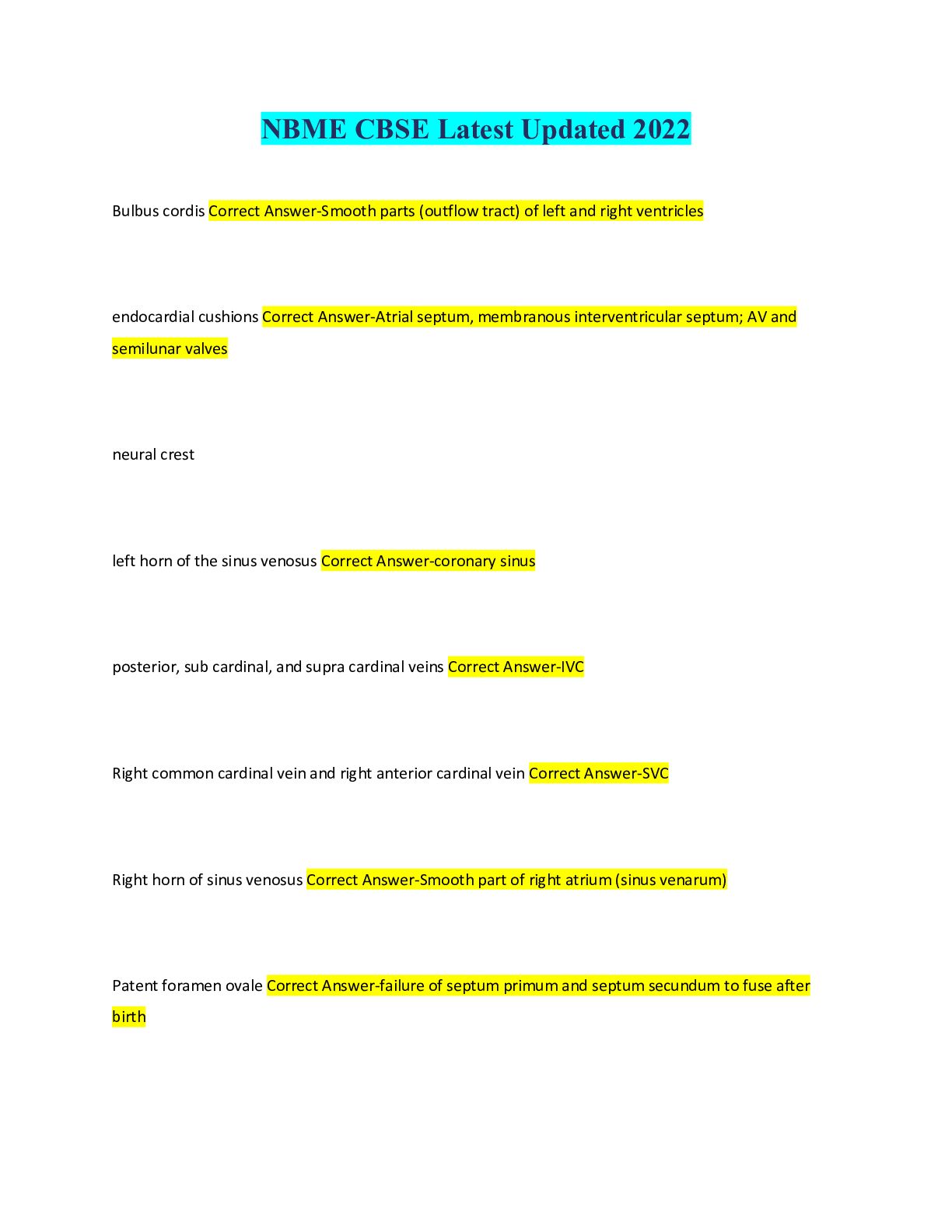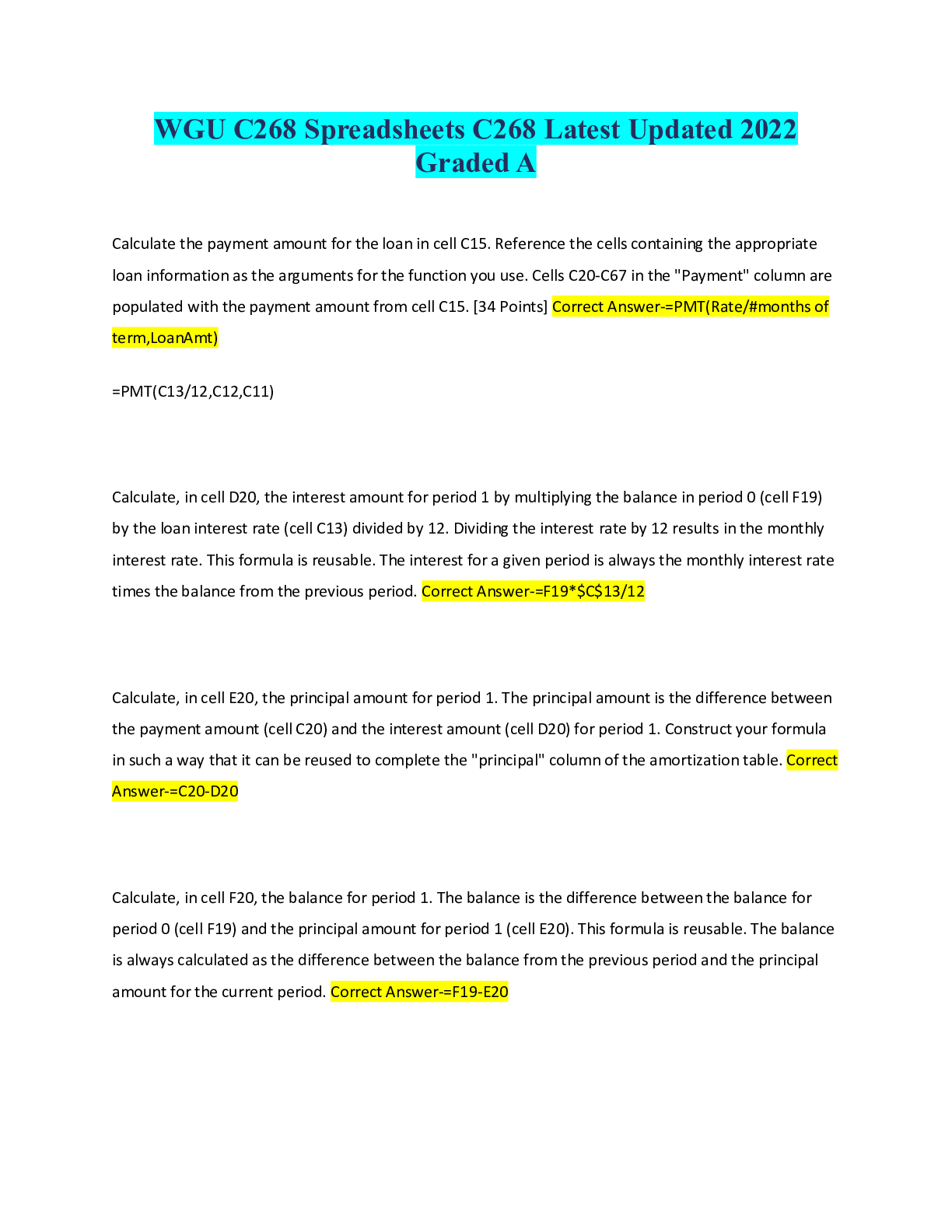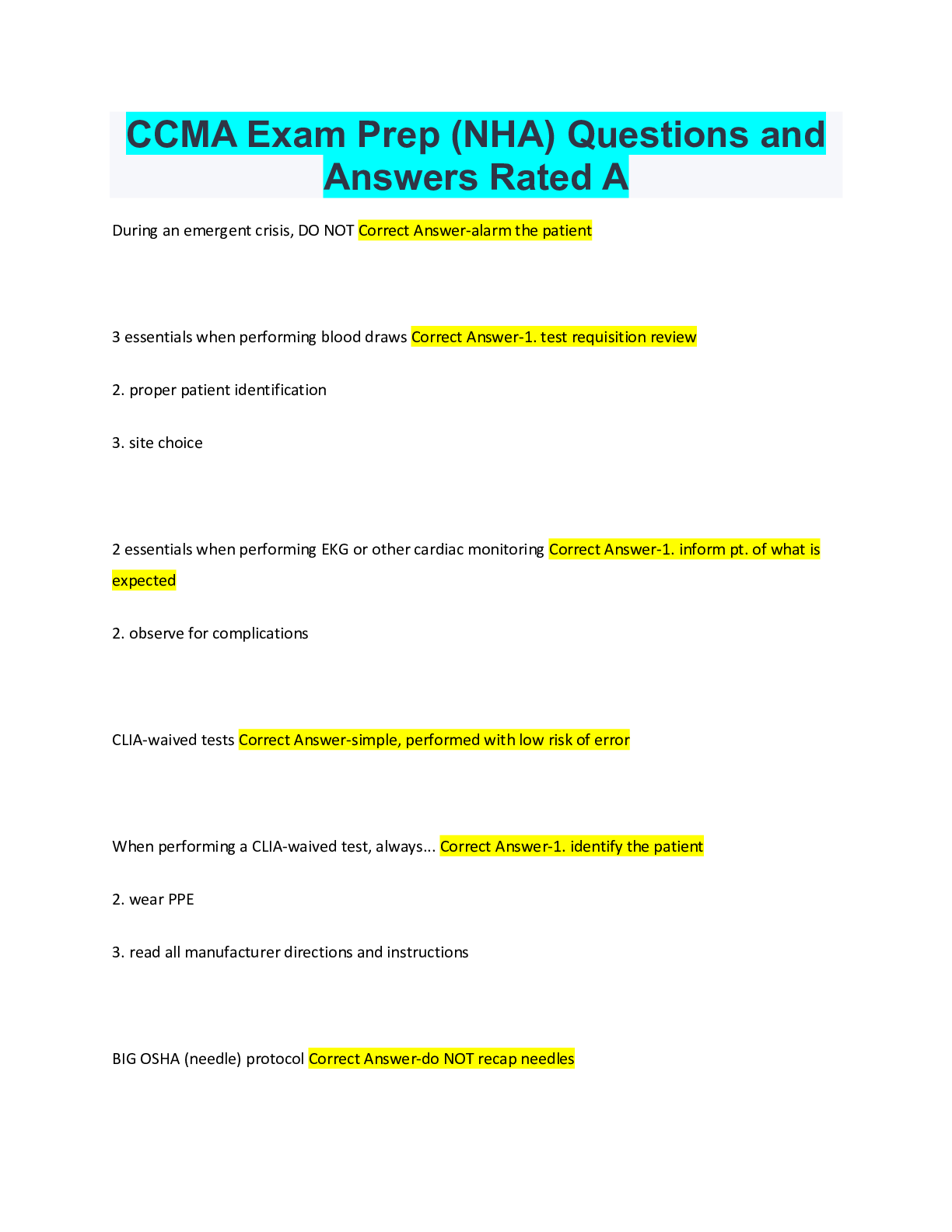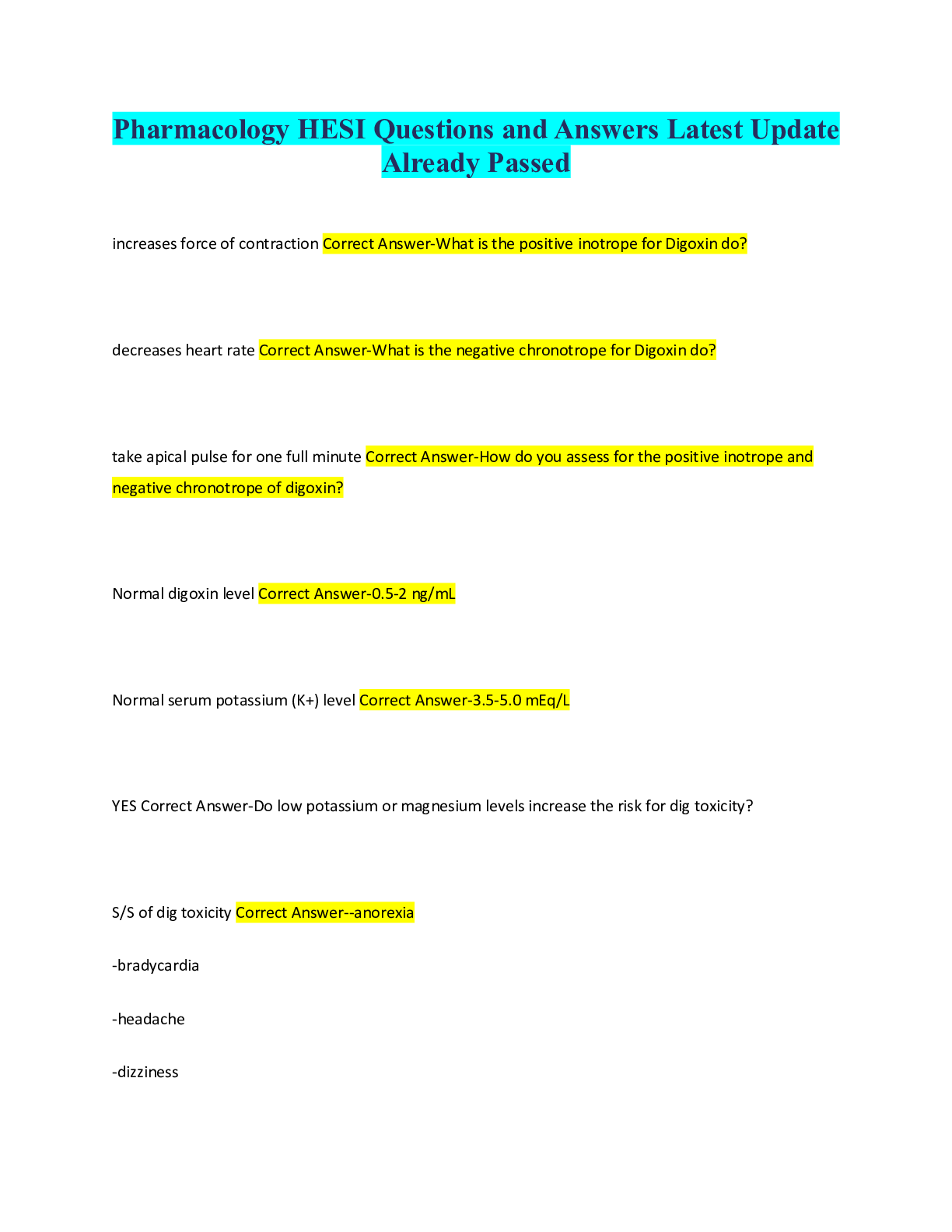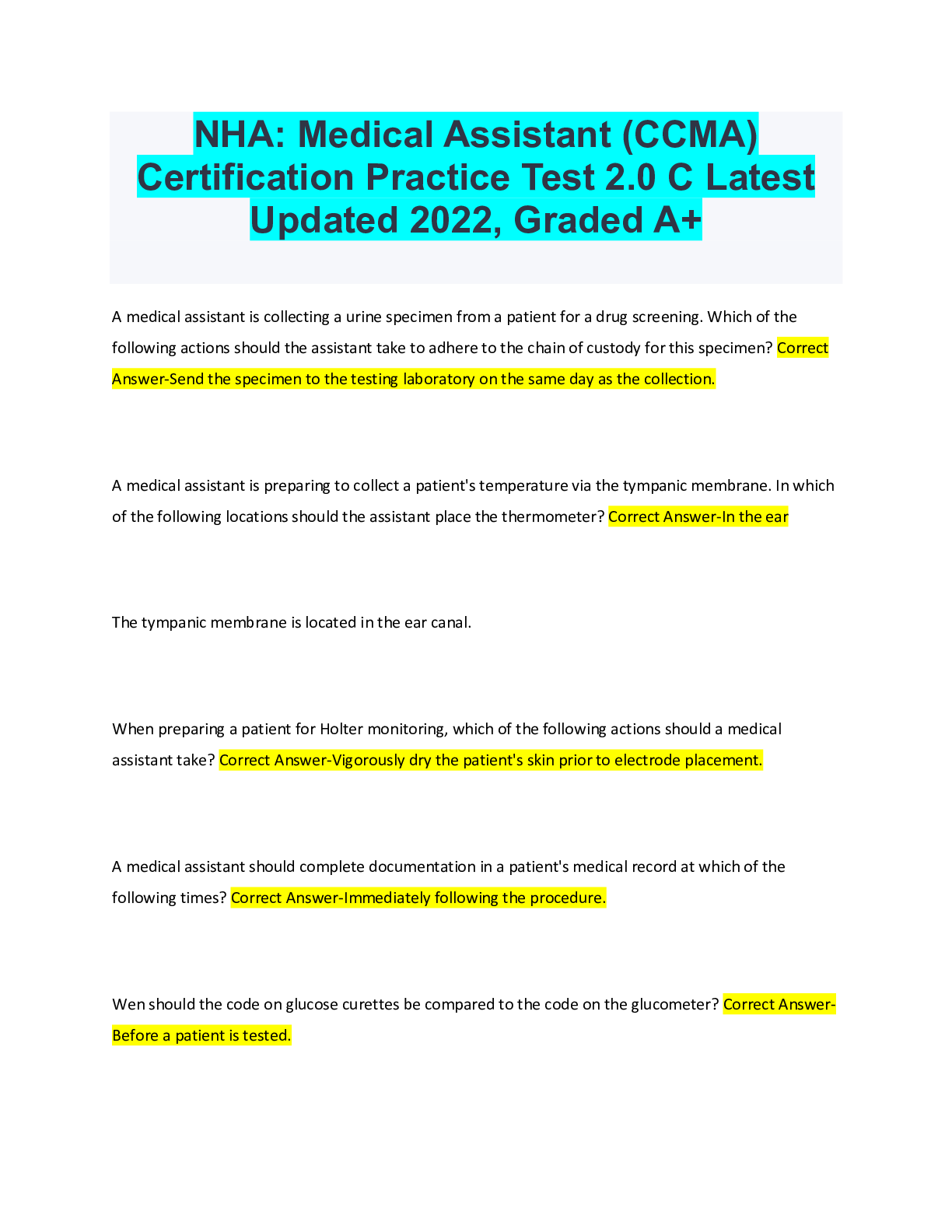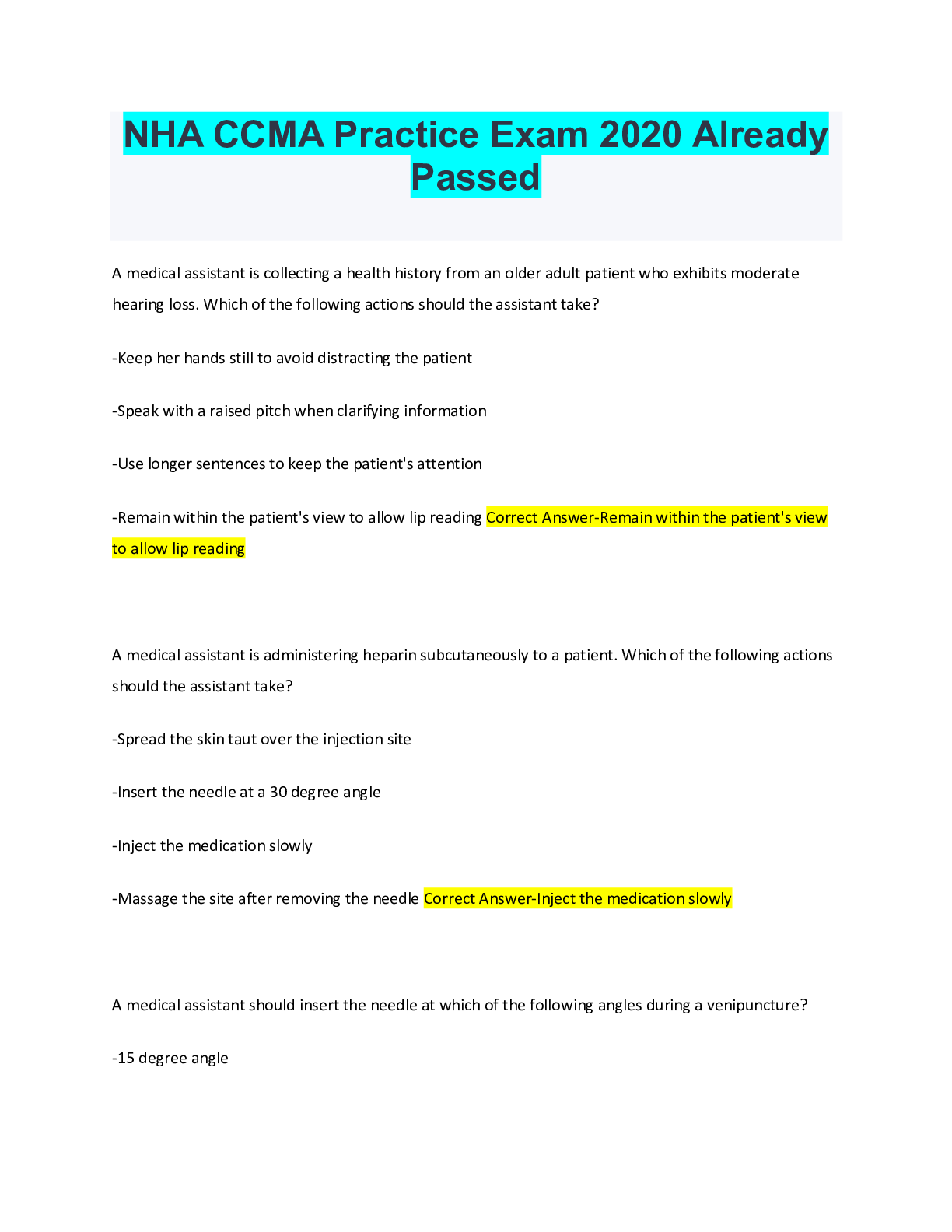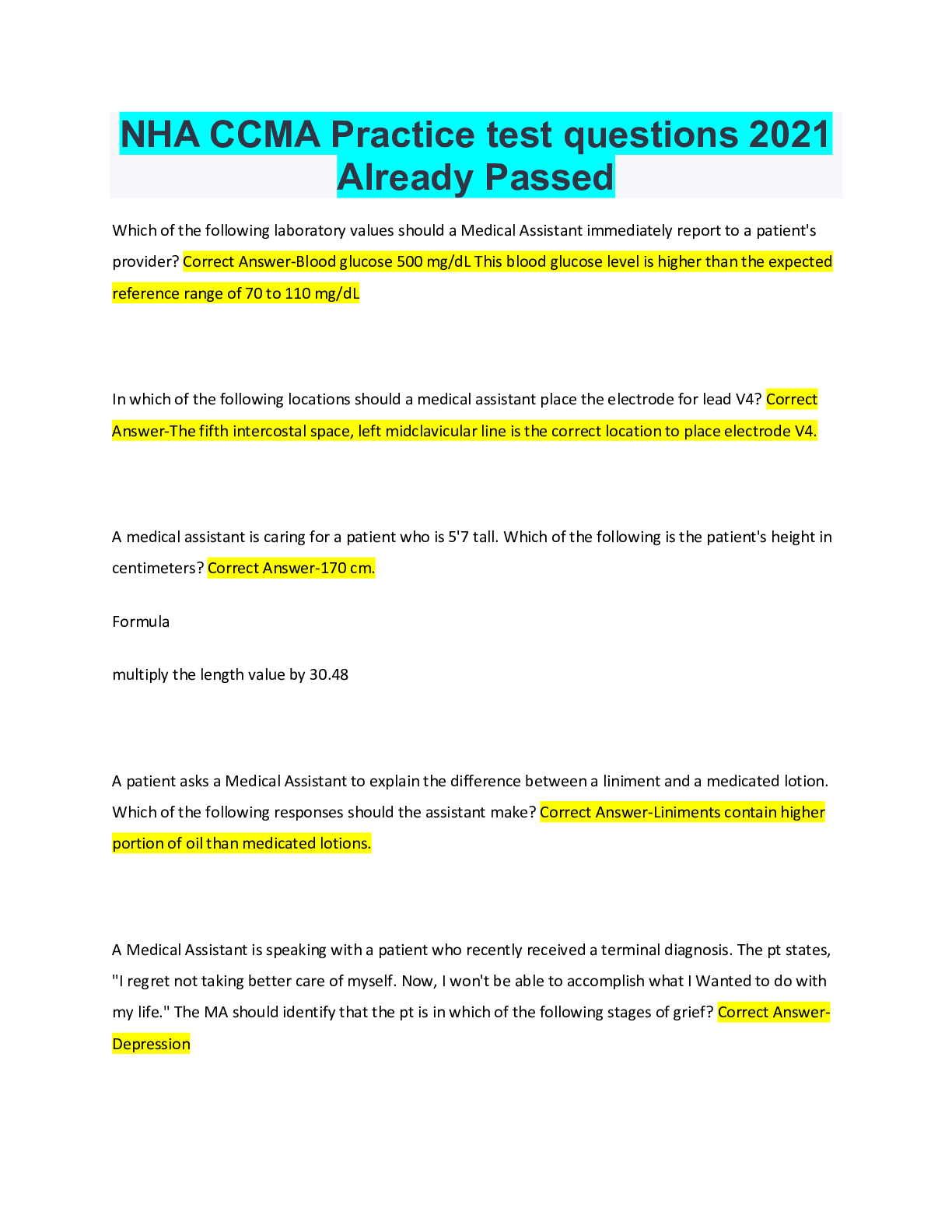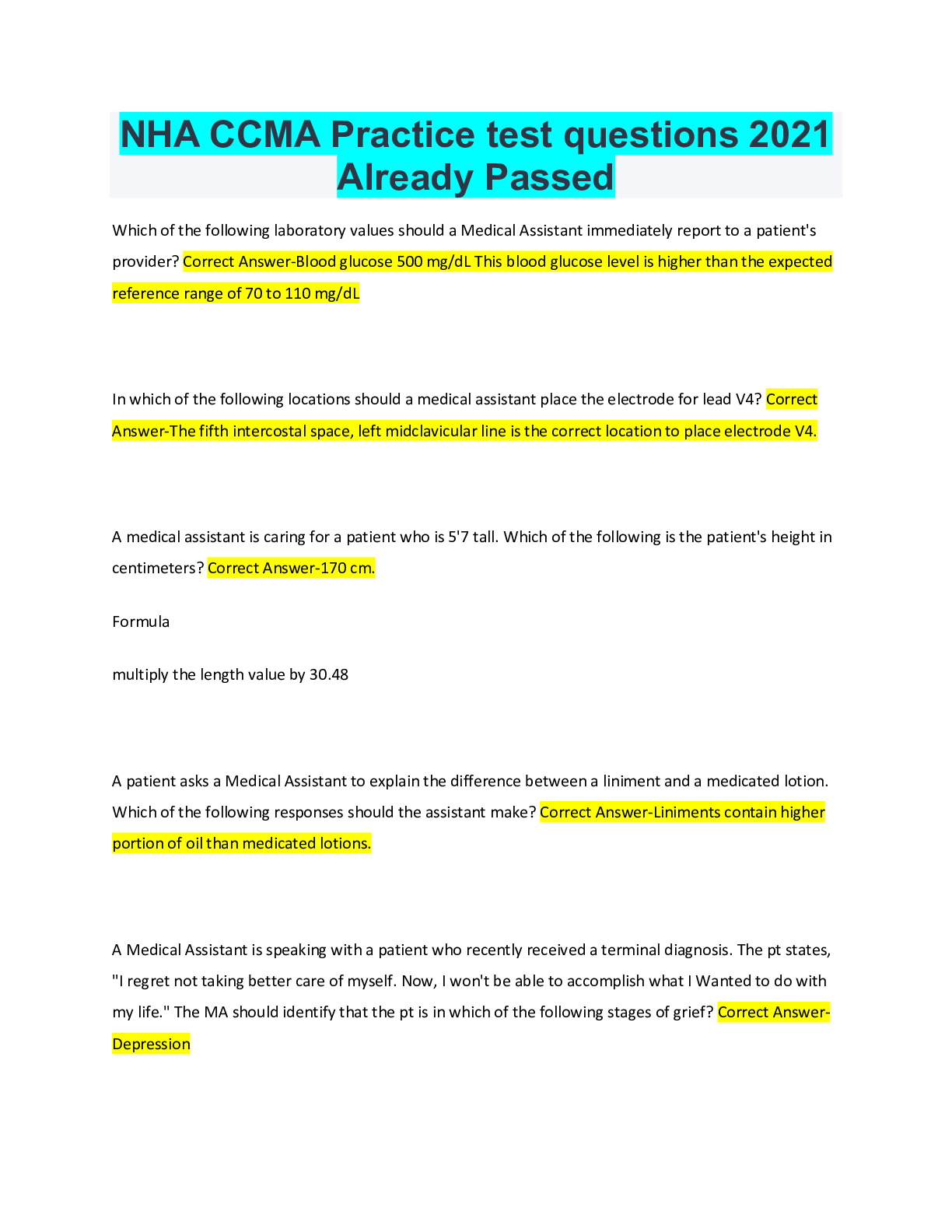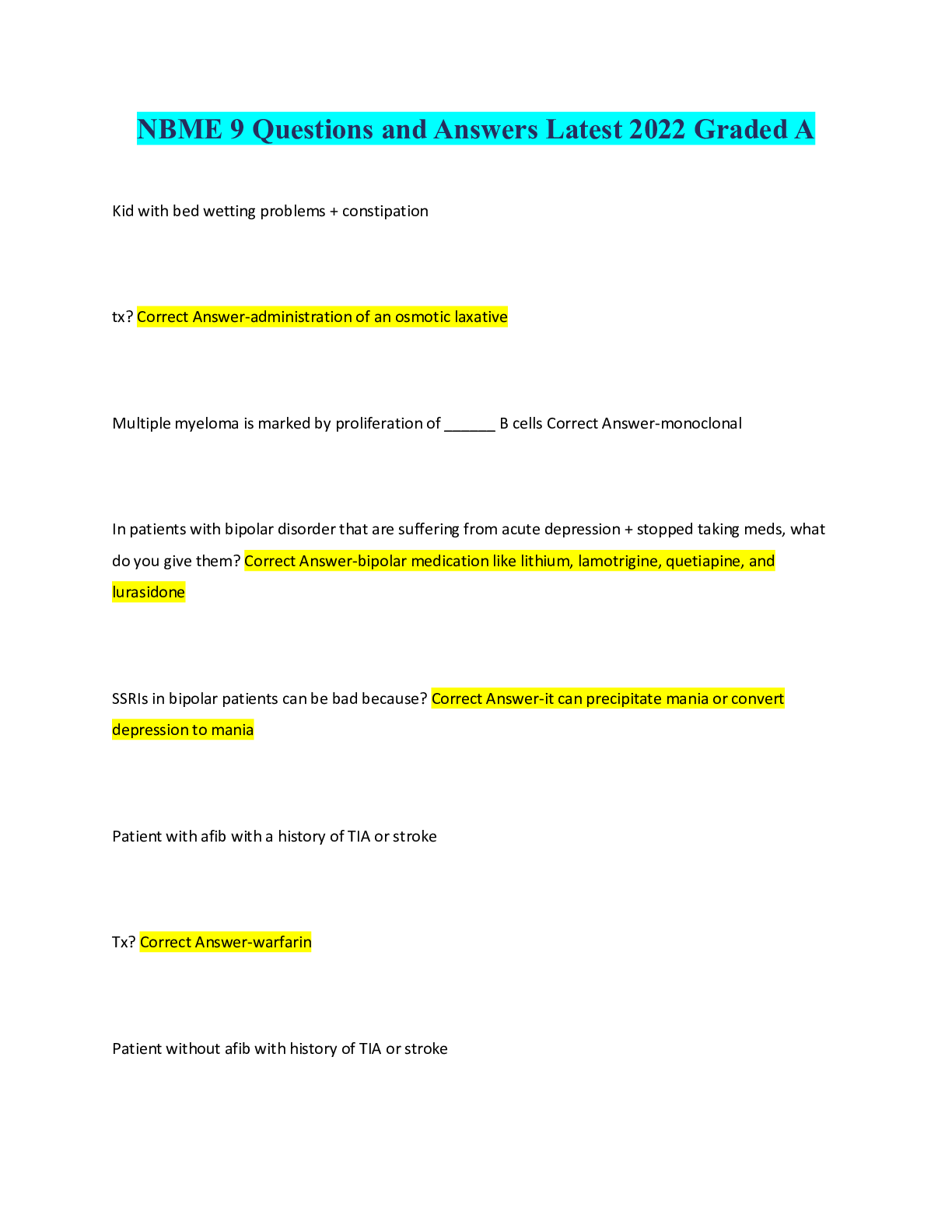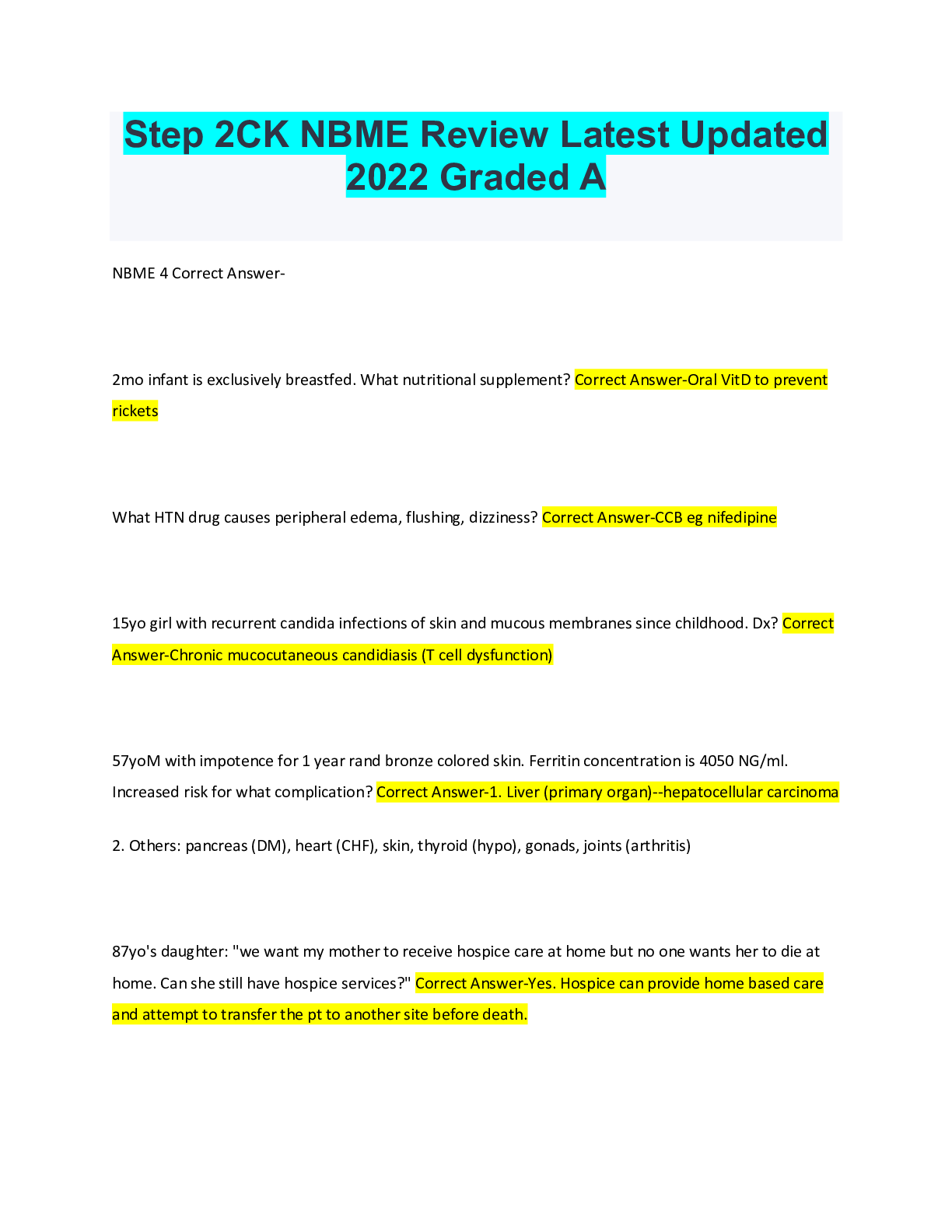*NURSING > A-Level Mark Scheme > NCSBN Practice Questions 1-15 Latest Updated Already Passed (All)
NCSBN Practice Questions 1-15 Latest Updated Already Passed
Document Content and Description Below
Which individual is at greatest risk for the development of hypertension? A. 40 year-old Caucasian nurse B. 60 year-old Asian-American shop owner C. 45 year-old African-American attorney D. 55 yea... r-old Hispanic teacher Correct Answer-C The incidence of hypertension is greater among African-Americans than other groups in the United States. The incidence among the Hispanic population is rising. A woman, who delivered five days ago and who had been diagnosed with pregnancy induced hypertension (PIH), calls a hospital triage nurse hotline to ask for advice. She states, "I have had the worst headache for the past two days. It pounds and by the middle of the afternoon everything I look at looks wavy. Nothing I have taken helps." What should the nurse do next? A. Advise the client to have someone bring her to the emergency room as soon as possible B. Ask the client to explain what she has taken and how often, and then evaluate other specific complaints C. Advise the client that the swings in her hormones may be the problem; suggest that she call her health care provider D. Ask the client to stay on the line, get the address, and send an ambulance to the home Correct Answer-D The woman is at risk for seizure activity. The ambulance needs to bring the woman to the hospital for evaluation and treatment. For at-risk clients, PIH may progress to preeclampsia and eclampsia prior to, during, or after delivery; this may occur up to 10 days after delivery. There's a new medication order that reads: "administer 1 gtt ciprofloxacin solution OD Q 4 h" What action should the nurse take? A. Squeeze one drop of the medication in the left eye every 4 hours B. Apply one drop in the right ear every 4 hours C. Call the prescriber to clarify and rewrite the order D. Ask other nurses for their interpretation of the order Correct Answer-C Abbreviations, symbols and dose designations can be misinterpreted and lead to medication errors. "OD" can mean "right eye" (oculus dexter) or "once daily"; it should never be used when communicating medical information. The abbreviation "Q" should be written out as "every." Although "gtt" is not on the official "Do Not Use List", it's best to use "drop" instead. Asking other nurses to interpret an order is a potentially dangerous "workaround." The nurse should call the health care provider who prescribed the medication and clarify the order. A client expresses anger when a call light is not answered within five minutes. The client demanded a blanket. How should the nurse respond? A. "I see this is frustrating for you. I have a few minutes so let's talk." B. "I am surprised that you are upset. The request could have waited a few more minutes." C. "Let's talk. Why are you upset about this?" D. "I apologize for the delay. I was involved in an emergency." Correct Answer-A This is the best response because it gives credence to the client's feelings and then concerns. To say "let's talk" and ask a why question is not a therapeutic approach because it does not acknowledge or validate the client's feelings. To apologize and not notice the client's feelings is inappropriate. To say it could have waited a few minutes is rude and non-accepting of the client's verbalized needs. The clinic nurse is assisting with medical billing. The nurse uses the DRG (Diagnosis Related Group) manual for which purpose? A. Determine reimbursement for a medical diagnosis B. Identify findings related to a medical diagnosis C. Classify nursing diagnoses from the client's health history D. Implement nursing care based on case management protocol Correct Answer-DRGs are the basis of prospective payment plans for reimbursement for Medicare clients. Other insurance companies often use it as a standard for determining payment. A nurse is planning care for a 2 year-old hospitalized child. Which issue will produce the most stress at this age? A. Fear of pain B. Separation anxiety C. Loss of control D. Bodily injury Correct Answer-B While a toddler will experience all of the stresses, separation from parents is the major stressor. Separation anxiety peaks in the toddler years. The nurse receives a client from the post anesthesia care unit following a left femoral-popliteal bypass graft procedure. Which of the following assessments requires immediate notification of the health care provider? A. Left foot is cool to the touch B. Absent left pedal pulse using Doppler analysis C. Inability to palpate the left pedal pulse D. Acute pain in the left lower leg Correct Answer-B Although the inability to palpate the left pedal pulse, a cool extremity, and increased pain in the left lower leg are important findings, they all require additional nursing assessment prior to contacting the health care provider. In clients without palpable pedal pulses, the next step in the assessment is to perform a Doppler analysis. The inability to locate the left pedal pulse using the Doppler analysis requires immediately notifying the health care provider. The nurse is reviewing the laboratory results for several clients. Which of the laboratory result indicates a client with partly compensated metabolic acidosis? A. PaCO2 30 mm Hg B. Hemoglobin 15 g/dL (150 g//L) C. Sodium 130 mEq/L (130 mmol/L) D. Chloride 100 mEq/L (100 mmol/L) Correct Answer-A Metabolic acidosis can be caused by many conditions, including renal failure, shock, severe diarrhea, dehydration, diabetic acidosis, and salicylate poisoning. With metabolic acidosis, you should expect a low pH (less than 7.35) and a low HCO3 (less than 22 mEq/L.) Compensation means the body is trying to get the pH back in balance; therefore, a pure metabolic acidosis should elicit a compensatory decrease in PaCO3 (normal is 35-45 mm Hg.) The hemoglobin is within normal limits (WNL) for both males and females. The chloride and sodium results are also WNL. A nurse is teaching a group of adults about modifiable cardiac risk factors. Which of the following should the nurse focus on first? A. Weight reduction B. Stress management C. Smoking cessation D. Physical exercise Correct Answer-C Smoking cessation is the priority for clients at risk for cardiac disease. Smoking's effects result in reduction of cell oxygenation and constriction of the blood vessels. All of the other factors should be addressed at some point in time. The client is admitted to an ambulatory surgery center and undergoes a right inguinal orchiectomy. Which option is the priority before the client can be discharged to home? A. Able to tolerate a regular diet B. Post-operative pain is managed C. Psychological counseling is scheduled D. Able to ambulate in the hallway with assistance Correct Answer-B An orchiectomy is the surgical removal of one or both testicles. It is usually performed to treat cancer (testicular, prostate or cancer of the male breast), but it may also be performed to prevent cancer (with an undescended testicle.) Due to the location of the incision, pain management is the priority. Most men will be able to eat regularly when they get home; they should at least tolerate liquids before discharge. It's important that the client is able to get up and walk with assistance, but this is not the priority. Psychological counseling may be needed as part of long-term aftercare, but this is not an immediate priority. A client is transported to the emergency department after a motor vehicle accident. When assessing the client 30 minutes after admission, the nurse notes several physical changes. Which finding would require the nurse's immediate attention? A. Increased restlessness B. Tachypnea C. Tachycardia D. Tracheal deviation Correct Answer-D Tracheal deviation is a sign that a mediastinal shift has occurred, most likely due to a tension pneumothorax. Air escaping from the injured lung into the pleural cavity causes pressure to build, collapsing the lung and shifting the mediastinum to the opposite side. This obstructs venous return to the heart, leading to circulatory instability and may result in cardiac arrest. This is a medical emergency, requiring emergency placement of a chest tube to remove air from the pleural cavity relieving the pressure. A client has a chest tube inserted immediately after surgery for a left lower lobectomy. During the repositioning of the client during the first postop check, the nurse notices 75 mL of a dark, red fluid flowing into the collection chamber of the chest drain system. What is the appropriate nursing action? A. Continue to monitor the rate of drainage B. Call the surgeon immediately C. Check to see if the client has a type and cross match D. Turn the client back to the original position Correct Answer-A It is not unusual for blood to collect in the chest and be released into the chest drain when the client changes position this soon after surgery. The dark color of the blood indicates it is not active bleeding inside of the chest. Sanguinous drainage should be expected within the initial 24 hours postop, progressing to serosanguinous and then to a serous type. If the drainage exceeds 100 mL/hr, the nurse should call the surgeon. The client with a T-2 spinal cord injury reports having a "pounding" headache. Further assessment by the nurse reveals excessive sweating, rash, pilomotor erection, facial flushing, congested nasal passages and a heart rate of 50. What action should the nurse take next? A. Assist client with relaxation techniques B. Measure the client's respirations, blood pressure, temperature and pupillary responses C. Check the client for bladder distention and the urinary catheter for kinks D. Place the client into the bed and administer the ordered PRN analgesic Correct Answer-C These are findings of autonomic dysreflexia, also called hyperreflexia. This response occurs in clients with a spinal cord injury above the T-6 level. It is typically initiated by any noxious stimulus below the level of injury such as a full bladder, an enema or bowel movement, fecal impaction, uterine contractions, changing of the catheter and vaginal or rectal examinations. The stimulus creates an exaggerated response of the sympathetic nervous system and can be a life-threatening event. The BP is typically extremely high. The priority action of the nurse is to identify and relieve the cause of the stimulus. A child is treated with succimer for lead poisoning. Which of these assessments should the nurse [Show More]
Last updated: 4 hours ago
Preview 5 out of 59 pages

Loading document previews ...
Buy this document to get the full access instantly
Instant Download Access after purchase
Add to cartInstant download
We Accept:

Reviews( 0 )
$10.50
Document information
Connected school, study & course
About the document
Uploaded On
Jul 16, 2024
Number of pages
59
Written in
Additional information
This document has been written for:
Uploaded
Jul 16, 2024
Downloads
0
Views
1


